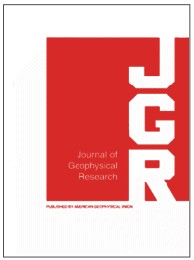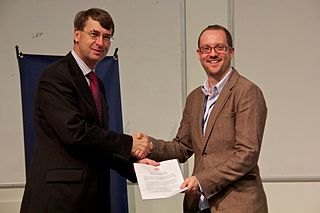
The Max Planck Society for the Advancement of Science is a formally independent non-governmental and non-profit association of German research institutes. Founded in 1911 as the Kaiser Wilhelm Society, it was renamed to the Max Planck Society in 1948 in honor of its former president, theoretical physicist Max Planck. The society is funded by the federal and state governments of Germany.

The Max Planck Institute for Astrophysics (MPA) is a research institute located in Garching, just north of Munich, Bavaria, Germany. It is one of many scientific research institutes belonging to the Max Planck Society.
The Max Planck Institute for Extraterrestrial Physics is part of the Max Planck Society, located in Garching, near Munich, Germany. In 1991 the Max Planck Institute for Physics and Astrophysics split up into the Max Planck Institute for Extraterrestrial Physics, the Max Planck Institute for Physics and the Max Planck Institute for Astrophysics. The Max Planck Institute for Extraterrestrial Physics was founded as sub-institute in 1963. The scientific activities of the institute are mostly devoted to astrophysics with telescopes orbiting in space. A large amount of the resources are spent for studying black holes in the galaxy and in the remote universe.

The Solar Orbiter (SolO) is a Sun-observing probe developed by the European Space Agency (ESA) with a National Aeronautics and Space Administration (NASA) contribution. Solar Orbiter, designed to obtain detailed measurements of the inner heliosphere and the nascent solar wind, will also perform close observations of the polar regions of the Sun which is difficult to do from Earth. These observations are important in investigating how the Sun creates and controls its heliosphere.
Solar physics is the branch of astrophysics that specializes in the study of the Sun. It deals with detailed measurements that are possible only for our closest star. It intersects with many disciplines of pure physics, astrophysics, and computer science, including fluid dynamics, plasma physics including magnetohydrodynamics, seismology, particle physics, atomic physics, nuclear physics, stellar evolution, space physics, spectroscopy, radiative transfer, applied optics, signal processing, computer vision, computational physics, stellar physics and solar astronomy.

The German Physical Society is the oldest organisation of physicists. The DPG's worldwide membership is cited as 52,220, as of 2022, making it one of the largest national physics societies in the world. The number of the DPG's members peaked in 2014, when it reached 63000, but it has been decreasing since then. It holds an annual conference and multiple spring conferences, which are held at various locations and along topical subjects of given sections of the DPG. The DPG serves the fields of pure and applied physics. Main aims are to bring its members and all physicists living in Germany closer together, represent their entirety outwards as well as foster the exchange of ideas between its members and foreign colleagues. The DPG binds itself and its members to advocate for freedom, tolerance, veracity and dignity in science and to be aware about the fact that the people working in science are responsible to a particularly high extent for the configuration of the overall human activity.

The heliospheric current sheet, or interplanetary current sheet, is a surface separating regions of the heliosphere where the interplanetary magnetic field points toward and away from the Sun. A small electrical current with a current density of about 10−10 A/m2 flows within this surface, forming a current sheet confined to this surface. The shape of the current sheet results from the influence of the Sun's rotating magnetic field on the plasma in the interplanetary medium. The thickness of the current sheet is about 10,000 km (6,200 mi) near the orbit of the Earth.

The Journal of Geophysical Research is a peer-reviewed scientific journal. It is the flagship journal of the American Geophysical Union. It contains original research on the physical, chemical, and biological processes that contribute to the understanding of the Earth, Sun, and Solar System. It has seven sections: A, B, C (Oceans), D (Atmospheres), E (Planets), F, and G (Biogeosciences). All current and back issues are available online for subscribers.

The Max Planck Institute for Solar System Research is a research institute in astronomy and astrophysics located in Göttingen, Germany, where it relocated in February 2014 from the nearby village of Lindau. The exploration of the Solar System is the central theme for research done at this institute.

Sami Khan Solanki is director of the Max Planck Institute for Solar System Research (MPS), director of the Sun-Heliosphere Department of MPS, a scientific member of the Max Planck Society, and a Chair of the International Max Planck Research School on Physical Processes in the Solar System and Beyond at the Universities of Braunschweig and Göttingen.

The Max Planck Institute for Medical Research in Heidelberg, Germany, is a facility of the Max Planck Society for basic medical research. Since its foundation, six Nobel Prize laureates worked at the Institute: Otto Fritz Meyerhof (Physiology), Richard Kuhn (Chemistry), Walther Bothe (Physics), André Michel Lwoff, Rudolf Mößbauer (Physics), Bert Sakmann and Stefan W. Hell (Chemistry).
Living Reviews is an open access journal series, which publishes regularly updated peer-reviewed review articles in various fields of science. Its concept of "living" articles takes advantage of web-based electronic publishing and allows authors to update their articles with the latest developments and research findings.
Living Reviews in Relativity is a peer-reviewed open-access scientific journal publishing reviews on relativity in the areas of physics and astrophysics. It was founded by Bernard Schutz and published at the Max Planck Institute for Gravitational Physics from 1998 to 2015. After it was sold by Max Planck Society in June 2015, it is now owned and published by Springer Science+Business Media.

Space Science Reviews is a peer-reviewed, scientific journal of space science. It was established in 1962, by Kees de Jager and is published now by Springer Nature B.V. The journal is currently edited by Hans Bloemen. Its purpose is to provide a comprehensive synthesis of the various branches of space research. The emphasis is on scientific results and instruments in the fields of astrophysics, physics of planetary systems, solar physics, and physics of magnetospheres & interplanetary matter. Space Science Reviews publishes Topical Collections, Review Articles, and Special Communications.
Nuclear Fusion is a peer reviewed international scientific journal that publishes articles, letters and review articles, special issue articles, conferences summaries and book reviews on the theoretical and practical research based on controlled thermonuclear fusion. The journal was first published in September, 1960 by IAEA and its head office was housed at the headquarter of IAEA in Vienna, Austria. Since 2002, the journal has been jointly published by IAEA and IOP Publishing.

Space climate is the long-term variation in solar activity within the heliosphere, including the solar wind, the Interplanetary magnetic field (IMF), and their effects in the near-Earth environment, including the magnetosphere of Earth and the ionosphere, the upper and lower atmosphere, climate, and other related systems. The scientific study of space climate is an interdisciplinary field of space physics, solar physics, heliophysics, and geophysics. It is thus conceptually related to terrestrial climatology, and its effects on the atmosphere of Earth are considered in climate science.

Eckart Marsch is a German theoretical physicist, who worked from 1980 to 2012 at the originally named Max Planck Institute for Aeronomy, from 2004 on named Max Planck Institute for Solar System Research (MPS) in Katlenburg-Lindau on the physics of the solar wind, solar corona and space plasmas and taught at the University of Göttingen.
Janet G. Luhmann is an American physicist and senior fellow of the Space Sciences Laboratory of the University of California, Berkeley. She has made major contributions to a wide range of topics in planetary, solar, magnetospheric, and heliospheric physics. She is the principal investigator of the IMPACT instrument suite on the twin-spacecraft STEREO mission. IMPACT stands for In-situ Measurements of Particles and Coronal mass ejection (CME) Transients. It consists of a, "suite of seven instruments that samples the 3-D distribution of solar wind plasma electrons, the characteristics of the solar energetic particle (SEP) ions and electrons, and the local vector magnetic field."

Mathew Owens is a British physicist and professor of space physics at the University of Reading in the UK. He has made major contributions to the understanding of the solar wind and space weather.
Manuela Temmer is Associate Professor of Astrophysics at the University of Graz, Austria and Head of the Heliospheric Physics Research Group. She is an expert in the science underpinning space weather forecasting.













